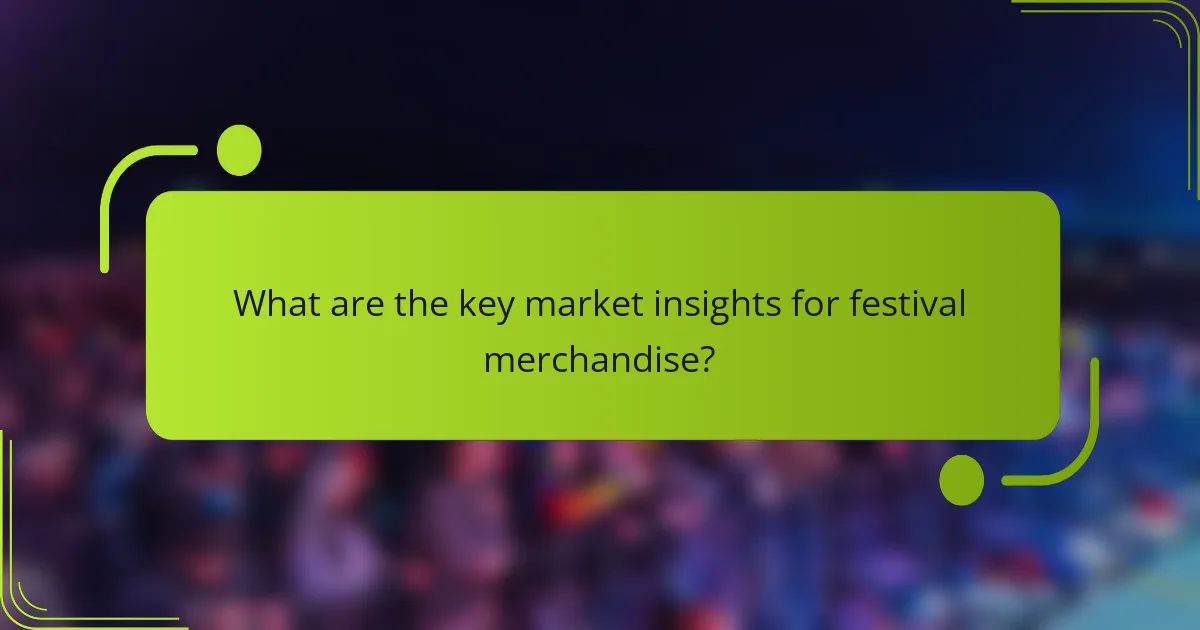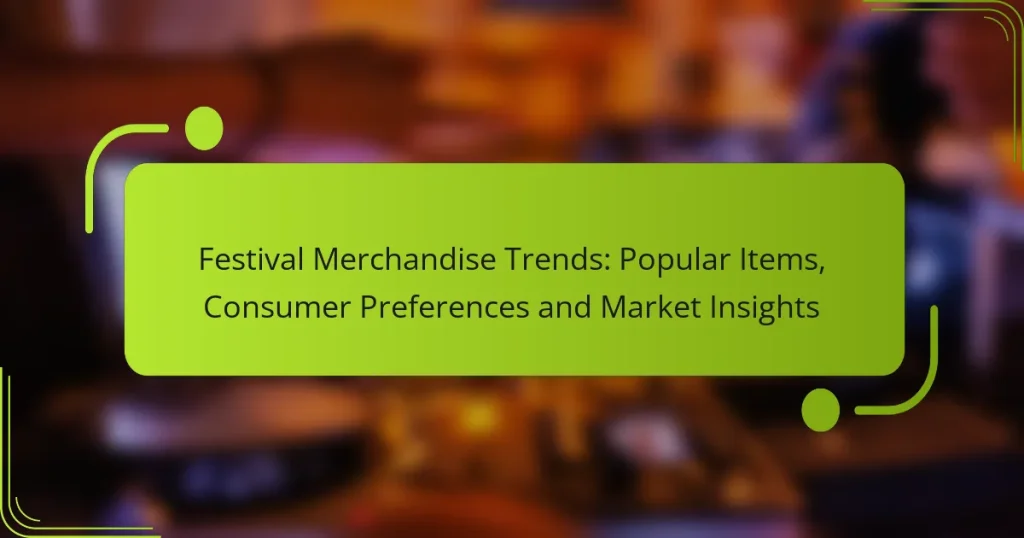In 2023, the festival merchandise landscape is characterized by a diverse array of popular items, including apparel, accessories, and eco-friendly products. As consumers seek unique and sustainable options that enhance their festival experience, understanding their preferences becomes crucial for vendors aiming to boost sales and engagement. The market is also witnessing a shift towards online sales and the impact of social media marketing, reflecting the evolving nature of consumer behavior.

What are the popular festival merchandise items in 2023?
In 2023, popular festival merchandise items include a mix of apparel, accessories, eco-friendly products, art, and music-related items. Consumers are increasingly looking for unique, sustainable, and expressive products that enhance their festival experience.
Apparel and clothing
Apparel remains a top choice for festival-goers, with t-shirts, tank tops, and hoodies featuring vibrant designs and festival branding. Lightweight, breathable fabrics are preferred, especially for outdoor events during warmer months.
Graphic tees and custom prints are particularly popular, allowing attendees to showcase their personal style. Many festivals offer exclusive merchandise, which can become collector’s items, driving demand for limited-edition clothing.
Accessories and jewelry
Accessories such as hats, sunglasses, and bags are essential for festival attendees. Items like fanny packs and crossbody bags are favored for their practicality and style, allowing hands-free convenience while enjoying the event.
Jewelry, including statement pieces and festival-themed designs, adds a personal touch to outfits. Many consumers opt for items that incorporate natural materials or unique craftsmanship, reflecting their individual tastes.
Eco-friendly products
As sustainability becomes a priority, eco-friendly products are gaining traction at festivals. Reusable water bottles, biodegradable utensils, and organic cotton bags are popular choices that align with environmentally conscious values.
Merchandise made from recycled materials or that supports local artisans is particularly appealing. Consumers are increasingly willing to pay a premium for products that contribute to a greener planet.
Art and crafts
Art and crafts play a significant role in festival merchandise, with handmade items like paintings, pottery, and textiles attracting attention. These unique pieces often reflect the festival’s culture and spirit, making them desirable keepsakes.
Local artists frequently showcase their work at festivals, providing attendees with the opportunity to purchase one-of-a-kind items while supporting the community. This trend emphasizes the importance of creativity and individuality in festival culture.
Music-related merchandise
Music-related merchandise, such as vinyl records, band merchandise, and posters, remains highly sought after. Fans often look for items that commemorate their favorite artists and performances, making these products valuable collectibles.
Additionally, many festivals offer exclusive music-related items, such as signed memorabilia or limited-edition releases, which can enhance the overall festival experience and serve as lasting reminders of the event.

How do consumer preferences shape festival merchandise?
Consumer preferences significantly influence festival merchandise by dictating what items are popular and how they are marketed. Understanding these preferences helps vendors tailor their offerings to meet the desires of festival-goers, enhancing sales and brand engagement.
Brand loyalty influences purchases
Brand loyalty plays a crucial role in consumer decisions when purchasing festival merchandise. Attendees often gravitate towards brands they trust or have previously enjoyed, leading to repeat purchases of familiar items. This loyalty can be cultivated through consistent quality and engaging marketing strategies.
For example, a festival-goer who has had positive experiences with a specific apparel brand is more likely to buy their merchandise at future events. Brands can leverage this by creating exclusive festival editions or collaborations that resonate with their loyal customer base.
Quality over quantity is prioritized
Today’s consumers tend to prioritize quality over quantity when selecting festival merchandise. Shoppers are willing to invest in fewer, high-quality items that offer durability and style rather than purchasing multiple lower-quality products. This trend reflects a growing awareness of sustainability and the desire for long-lasting goods.
Merchants should focus on sourcing materials that enhance the quality of their products, such as organic cotton or recycled materials. Offering a limited selection of well-crafted items can also create a sense of exclusivity and appeal to discerning festival-goers.
Personalization trends are rising
Personalization is becoming increasingly important in the festival merchandise market. Consumers appreciate items that reflect their individual style or experiences, prompting brands to offer customizable options. This trend can include personalized prints, unique color choices, or even bespoke designs.
Vendors can enhance customer engagement by providing on-site customization stations or online pre-order options for personalized merchandise. This approach not only boosts sales but also fosters a deeper connection between the consumer and the brand, making the merchandise more meaningful.

What are the key market insights for festival merchandise?
The festival merchandise market is evolving rapidly, driven by changing consumer preferences and technological advancements. Key insights reveal a significant shift towards online sales, the influence of social media marketing, and a growing demand for sustainable products.
Growth in online sales channels
Online sales channels for festival merchandise have seen substantial growth, particularly in recent years. Many consumers prefer the convenience of shopping from home, leading to a surge in e-commerce platforms dedicated to festival gear.
Merchandise sales during festivals can now be boosted through websites and mobile apps, allowing for direct-to-consumer sales. This trend is particularly strong in regions with high internet penetration, where consumers expect seamless online shopping experiences.
Impact of social media marketing
Social media marketing plays a crucial role in promoting festival merchandise, as platforms like Instagram and TikTok allow brands to reach targeted audiences effectively. Engaging content, such as influencer partnerships and user-generated posts, can significantly enhance brand visibility.
Festivals often leverage social media campaigns to create buzz around exclusive merchandise drops, driving urgency and excitement among fans. Brands that actively interact with their audience on these platforms tend to see higher conversion rates and customer loyalty.
Shift towards sustainable products
There is a noticeable shift towards sustainable products in the festival merchandise market, as consumers increasingly prioritize eco-friendly options. Many festival-goers are now looking for items made from recycled materials or those that promote environmental awareness.
Brands that adopt sustainable practices not only attract environmentally conscious consumers but also differentiate themselves in a crowded market. Offering products like reusable bags, organic cotton apparel, and biodegradable accessories can enhance brand reputation and appeal.

What factors influence festival merchandise pricing?
Festival merchandise pricing is influenced by various factors including production costs, brand reputation, and market demand fluctuations. Understanding these elements can help vendors set competitive prices while maximizing profit margins.
Cost of production
The cost of production directly impacts the pricing of festival merchandise. This includes expenses such as materials, labor, and manufacturing processes. For example, high-quality fabrics or unique designs may lead to higher production costs, which in turn can increase retail prices.
Vendors should consider economies of scale; producing larger quantities can reduce per-unit costs. However, they must balance this with the risk of overproduction, which can lead to excess inventory and markdowns.
Brand reputation
Brand reputation plays a significant role in determining merchandise prices at festivals. Well-established brands can command higher prices due to perceived quality and customer loyalty. For instance, a popular band’s merchandise may sell for a premium compared to lesser-known artists.
Newer or lesser-known brands may need to adopt competitive pricing strategies to attract customers. Building a strong brand identity through quality products and effective marketing can gradually justify higher prices over time.
Market demand fluctuations
Market demand fluctuations can significantly influence festival merchandise pricing. During peak festival seasons, demand often rises, allowing vendors to increase prices. Conversely, during off-peak times, prices may need to be lowered to stimulate sales.
Vendors should monitor trends and consumer preferences closely. Utilizing data analytics can help predict demand shifts, enabling timely adjustments to pricing strategies. Offering limited edition items or exclusive designs can also create urgency and drive up demand.

How do festivals in North America compare to Europe in merchandise trends?
Festivals in North America and Europe exhibit distinct merchandise trends influenced by cultural preferences, spending habits, and event types. While both regions prioritize unique and branded items, North American festivals often see higher consumer spending on merchandise compared to their European counterparts.
Differences in consumer spending
Consumer spending at festivals varies significantly between North America and Europe. In North America, attendees may spend upwards of $50 to $100 on merchandise per event, driven by a strong emphasis on branded apparel and exclusive items. In contrast, European festival-goers typically spend less, often ranging from €20 to €50, focusing more on functional items like reusable drinkware and eco-friendly products.
Factors influencing these spending habits include the overall festival experience, ticket prices, and local economic conditions. North American festivals often incorporate more extensive merchandise offerings, which can lead to higher impulse purchases. European festivals, however, may prioritize sustainability, encouraging attendees to invest in practical items that align with eco-conscious values.


